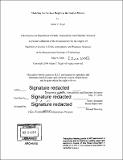Modeling sea surface height in the Gulf of Mexico
Author(s)
Rigel, Adam C
DownloadFull printable version (4.485Mb)
Other Contributors
Massachusetts Institute of Technology. Department of Earth, Atmospheric, and Planetary Sciences.
Advisor
Kerry Emanuel.
Terms of use
Metadata
Show full item recordAbstract
A model was created to form synthetic plots of sea surface height (SSH) from monthly SSH statistics in the Gulf of Mexico generated from satellite laser altimetry data. SSH is a signal of the upper ocean mixed layer heat content and is an input for hurricane intensity models. A significant ocean feature in the Gulf of Mexico is the Loop Current (LC) which sheds warm eddies into the Gulf of Mexico at irregular intervals, which adds to the variability in monthly SSH readings beyond seasonal change. Satellite laser altimetry data was used from October 14th 1992 to May 23rd 2007. The SSH data included an area of the Gulf of Mexico (16°N-30°N latitude, 80°W-100°W longitude) with a resolution of 1/3° by 1/3° on a Mercator grid. Monthly SSH averages, variances, and covariances were created from a total of 763 samples, which allowed for approximately 65 samples per month. Once monthly SSH averages, variances, and covariances were made, synthetic plots were made by using a Karhunen-Loève transform, the Singular Variable Decomposition of the SSH monthly covariance, and random vector composed of random numbers in a Gaussian distribution. Differences in synthetic SSH plots compared to individual SSH observations could vary greatly; the average of all synthetic SSH plot nodes differed by no more than plus or minus 10 cm. The difference between observed and synthetic SSH variance was no more than 400 cm². The large differences occurred in the in the eddy shedding region of the LC. To assess the effectiveness of the model, the synthetic SSH model will need to be used in a hurricane intensity model.
Description
Thesis: S.B., Massachusetts Institute of Technology, Department of Earth, Atmospheric, and Planetary Sciences, 2008. Cataloged from PDF version of thesis. "May 9, 2008." Includes bibliographical references (pages 25-26).
Date issued
2008Department
Massachusetts Institute of Technology. Department of Earth, Atmospheric, and Planetary SciencesPublisher
Massachusetts Institute of Technology
Keywords
Earth, Atmospheric, and Planetary Sciences.